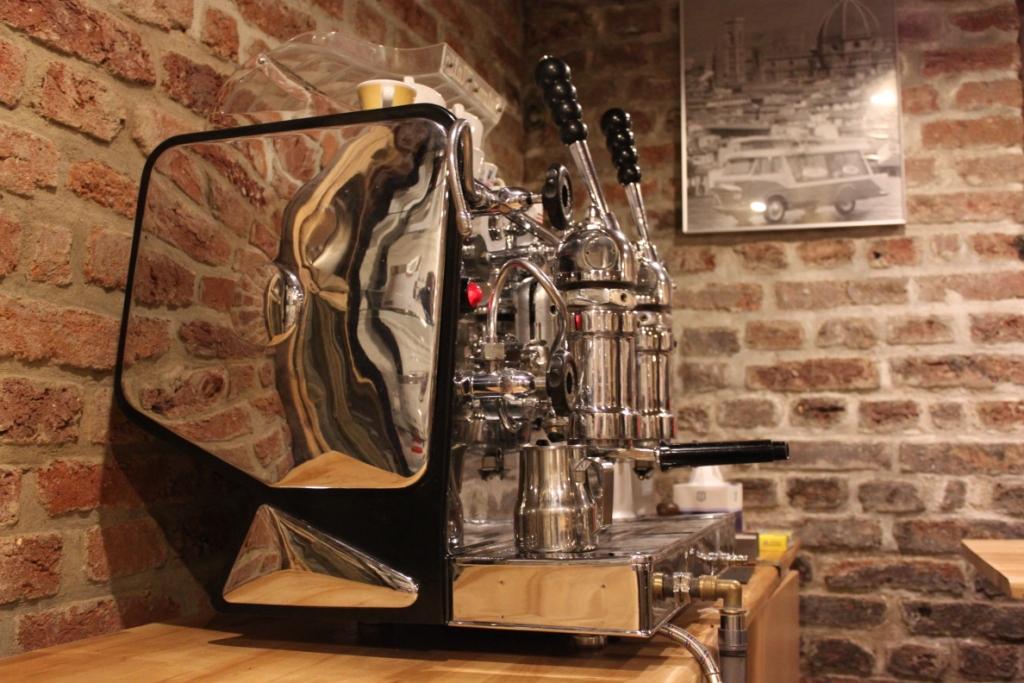



We got our hands on this beautiful piece. It is a professional Gaggia lever coffee machine from the 50th century. The coffee machine is not equipped with an electric pump, but with a lever system, where the espresso is prepared at variable water pressure by means of a spring and a piston.
The entire control is completely manual, including filling the level into the boiler. It was found in a deplorable condition, the owner had it repaired by Enric Maltoni, probably the most professional man. I really admire his work, everything has been preserved. The coffee machine has a maximum of original parts, even with numerous scars. Everything that was gone was chrome-plated again, free of rust and dirt. All moving parts are lubricated and resealed, although not perfectly, as we later found out. The coffee machine was originally for gas heating, but it is not allowed in the Czech Republic, so it was converted to electric. It was a bit of a stumbling block, as the Italians installed two heaters with a total input of 7 kW and a current of 28A per phase in the boiler. There is no circuit breaker that can keep this going. We were no exception. Finally, we disconnected one heater so we could test the coffee machine. The owner of the coffee machine asked us to test the coffee machine in operation. Since we are the right fools, it was our pleasure to break this old man and make dozens of espressos and cappuccinos out of him. The coffee machine is not equipped with a vacuum valve, so it was necessary to open the steam nozzle when heating to allow air to escape from the boiler. As soon as steam began to escape from the nozzle, it was necessary to close it and let the coffee machine pressurize. After about 25 minutes of waiting for the coffee machine to warm up, when our hands were already itching and our tongues were ready for an extraordinary experience, the moment came to prepare the first espresso. The first few espressos went to waste classically before we found the right roughness. The coffee machine requires a pinch of finer grinding than an espresso machine with a pump. The moment came for the first proper espresso extraction. We were a little surprised that it was necessary to "pump" three times to reach a volume of 30 ml. The joy was a little hardened at first by a slight, after a few espresso, quite a massive leak of water from various parts of the coffee machine's heads. To our delight, however, it did not have much effect on the taste of the coffee in the cup. The espresso had a slightly lower temperature, as it was a coffee blend with a robust, it was more of a plus than a minus. The coffee tasted completely different from the classic modern coffee machine. She was far more complex with a decent body. This is due to the pre-infusion and the pressure curve, when the pressure at the beginning of the extraction is the highest (the spring is the most contracted) and with the ongoing extraction the pressure gradually decreases to zero. Interestingly, this pressure profile is one of the pre-programmed pressure profiles of the La Marzocco Strada coffee machine. We were not so satisfied with the test with single-species coffee. We used Costarica San Raffael Tarrazzú coffee. The result was an uncomfortably sour cup of coffee with a weak body. This was probably due to the low water temperature. We have not moved anywhere by regulating the coffee grinder and increasing the weight. So we stayed with the mixture with 30% robusta. Then we thought of trying to see if it was possible to do latte art in 1956. No one trusted the strangely twisted, unadjustable steam jets. But we went for it! As you can see in the photos - yes, it was already possible to create latte art back then - if they had the same milk as we do today, which I certainly can't say for sure. We ceremoniously showed the coffee maker to the owner, explained to him the work with him, including all the flies. The coffee machine then set out for the café, where it will not only be seen but also used. I won't say yet who the lucky guy who will have such a beautiful piece in the cafe. I'm sure everyone will find out soon enough. There are not many such coffee machines in the world, let alone in the Czech Republic. In conclusion, this coffee machine can really squeeze a lot out of coffee, but it needs to be done much more than usual. From an operational point of view, it's a complete disaster, I can't imagine this coffee machine in a crowded cafe. However, if you have time for that, there is no doubt that this machine can reward you for your efforts.




Share:
Turn off the coffee machine for the night?
La Marzocco Strada